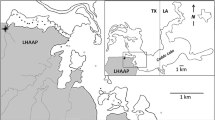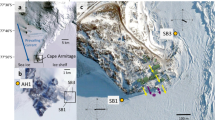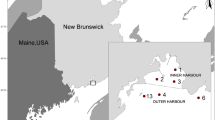Abstract
Synoptic data on concentrations of sediment-associated chemical contaminants and benthic macroinfaunal community structure were collected from 1,389 stations in estuaries along the U.S. Atlantic and Gulf of Mexico coasts as part of the nationwide Environmental Monitoring and Assessment Program (EMAP). These data were used to develop an empirical framework for evaluating risks of benthic community-level effects within different ranges of sediment contamination from mixtures of multiple chemicals present at varying concentrations. Sediment contamination was expressed as the mean ratio of individual chemical concentrations relative to corresponding sediment quality guidelines (SQGs), including Effects Range-Median (ERM) and Probable Effects Level (PEL) values. Benthic condition was assessed using diagnostic, multi-metric indices developed for each of three EMAP provinces (Virginian, Carolinian, and Louisianian). Cumulative percentages of stations with a degraded benthic community were plotted against ascending values of the mean ERM and PEL quotients. Based on the observed relationships, mean SQG quotients were divided into four ranges corresponding to either a low, moderate, high, or very high incidence of degraded benthic condition. Results showed that condition of the ambient benthic community provides a reliable and sensitive indicator for evaluating the biological significance of sediment-associated stressors. Mean SQG quotients marking the beginning of the contaminant range associated with the highest incidence of benthic impacts (73–100% of samples, depending on the province and type of SQG) were well below those linked to high risks of sediment toxicity as determined by short-term toxicity tests with single species. Measures of the ambient benthic community reflect the sensitivities of multiple species and life stages to persistent exposures under actual field conditions. Similar results were obtained with preliminary data from the west coast (Puget Sound).
Similar content being viewed by others
References
Chapman, P.M.: 1989, ‘Current Approaches to Developing Sediment Quality Criteria,’ Environmental Toxicology and Chemistry 8, 589–599.
Chung, K.: 1999, ‘Toxicity of Cadmium, DDT, and Fluoranthene to Juvenile Mercenaria mercenaria in Aqueous and Sediment Bioassays,’ Masters Thesis, University of Charleston South Carolina, Charleston, SC, 123 pp.
Diaz, R.J. and Rosenberg, R.: 1995, ‘Marine Benthic Hypoxia: A Review of its Ecological Effects and the Behavioural Responses of Benthic Macrofauna,’ Oceanography and Marine Biology: an Annual Review, 33, 245–303.
Engle, V.D. and Summers, J.K.: 1999, ‘Refinement, Validation, and Application of a Benthic Condition Index for Gulf of Mexico Estuaries,’ Estuaries 22, 624–635.
Holland, A.F. (ed.): 1990, ‘Near Coastal Program Plan for 1990: Estuaries,’ EPA/600/4–90/033, U.S. EPA, Atlantic Ecology Division, Narragansett, RI.
Hyland, J.L., Van Dolah, R.F. and Snoots, T.R.: 1999, ‘Predicting Stress in Benthic Communities of Southeastern U.S. Estuaries in Relation to Chemical Contamination of Sediments,’ Environmental Toxicology and Chemistry 18, 2557–2564.
Lauenstein, G.G. and Cantillo, A.Y.: 1993, ‘Sampling and Analytical Methods of the National Status and Trends Program: National Benthic Surveillance and Mussel Watch Projects, 1984–1992, Volumes III and IV,’ NOAA Technical Memorandum NOS ORCA 71, NOAA National Ocean Service, Silver Spring, MD, 219 pp (Volume III) and 182 pp (Volume IV).
Long, E.R., Field, L.J. and MacDonald, D.D.: 1998, ‘Predicting Toxicity in Marine Sediments With Numerical Sediment Quality Guidelines,’ Environmental Toxicology and Chemistry 17, 714–727.
Long, E.R., Hameedi, J.J., Sloane, G.M. and Read, L.: In review, 'Chemical contamination, toxicity, and benthic community indices in sediments of the lower Miami River and adjoining portions of Biscayne Bay, Florida, Estuaries (submitted March 2001).
Long, E.R., and MacDonald, D.D.: 1998, ‘Recommended Uses of Empirically Derived, Sediment Quality Guidelines for Marine and Estuarine Ecosystems,’ Human and Ecological Risk Assessment 4, 1019–1039.
Long, E.R., MacDonald, D.D., Severn, C.G., and Hong, C.B.: 2000, ‘Classifying the probabilities of acute toxicity in marine sediments with empirically-derived sediment quality guidelines,’ Environmental Toxicology and Chemistry 19, 2598–2601.
Long, E.R., MacDonald, D.D., Smith, S.L. and Calder, F.D.: 1995, ‘Incidence of Adverse Biological Effects Within Ranges of Chemical Concentrations in Marine and Estuarine Sediments,’ Environmental Management 19, 81–97.
MacDonald, D.D, Carr, R.S., Calder, F.D., Long, E.R. and Ingersoll, C.G.: 1996, ‘Development and Evaluation of Sediment Quality Guidelines for Florida Coastal Waters,’ Ecotoxicology 5, 253–278.
Paul, J.F., Gentile, J.H., Scott, K.J., Schimmel, S.C., Campbell, D.E. and Latimer, R.W.: 1999, ‘EMAP-Virginian Province Four-Year Assessment Report (1990–93),’ EPA/600/R-99/004, U.S. EPA, Atlantic Ecology Division, Narragansett, RI, 119 pp.
Shannon, C.E. and Weaver, W.: 1949, The Mathematical Theory of Communication, University of Illinois Press, Urbana, IL, USA.
Summers, J.K., Macauley, J.M., Heitmuller, P.T., Engle, V.D., Adams, A.M. and Brooks, G.T.: 1992, ‘Annual Statistical Summary: EMAP-Estuaries Louisianian Province-1991,’ EPA/600/ R-93/001, U.S. EPA, Gulf Ecology Division, Gulf Breeze, FL, 101 pp. and 3 Appendices.
Swartz, R.C., Shultz, D.W., Ditsworth, G.R., DeBen, W.A. and Cole, F.A.: 1985, ‘Sediment Toxicity, Contamination, and Macrobenthic Communities Near a Large Sewage Outfall,’ in: Boyle, T.T. (ed.), Validation and Predictability of Laboratory Methods for Assessing the Fate and Effects of Contaminants in Aquatic Ecosystems, ASTM STP 865, American Society for Testing and Materials, Philadelphia, PA, pp. 152–175.
U.S. Environmental Protection Agency: 1995, ‘Environmental Monitoring and Assessment Program: Laboratory Methods Manual-Estuaries. Volume 2: Chemical Methods,’ EPA/620/R-95/ 009, U.S. EPA, ORD, Washington, D.C.
Valette-Silver, N.J.: 1993, ‘The Use of Sediment Cores to Reconstruct Historical Trends in Contamination of Estuarine and Coastal Sediments,’ Estuaries 16, 577–588.
Van Dolah, R.F., Hyland, J.L., Holland, A.F., Rosen, J.S. and Snoots, T.R.: 1999, ‘A Benthic Index of Biological Integrity for Assessing Habitat Quality in Estuaries of the Southeastern USA,’ Marine Environmental Research 48, 1–15.
Author information
Authors and Affiliations
Rights and permissions
About this article
Cite this article
Hyland, J.L., Balthis, W.L., Engle, V.D. et al. Incidence of Stress in Benthic Communities along the U.S. Atlantic and Gulf of Mexico Coasts within Different Ranges of Sediment Contamination from Chemical Mixtures. Environ Monit Assess 81, 149–161 (2003). https://doi.org/10.1023/A:1021325007660
Issue Date:
DOI: https://doi.org/10.1023/A:1021325007660




